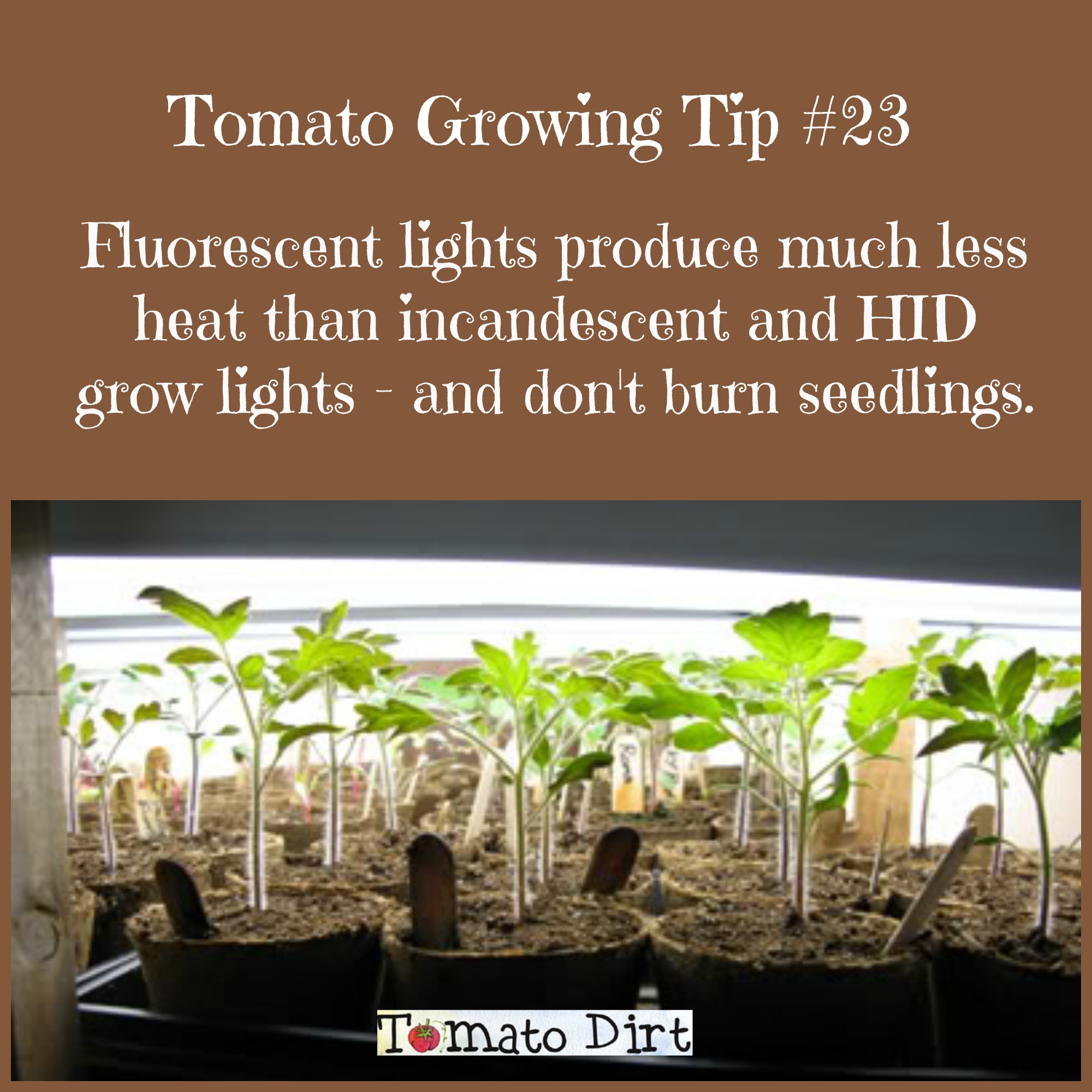Using Fluorescent Grow Lights to Start and Grow Tomatoes Indoors
Since 2010, Tomato Dirt has garnered 4.8+ million views, making it the web’s leading online source for growing tomatoes in the home garden. Award-winning writer and Tomato Dirt owner Kathy Widenhouse has helped thousands of home gardeners grow healthier tomatoes. Be one of them when you get Tomato Dirt’s Growing Guide here.
Fluorescent grow lights are one of the most popular options for home gardeners who want to start seeds and grow tomatoes indoors.
In the past, standard fluorescents were primarily used for starting seedlings.
Their inefficiency meant they weren't suitable for sustaining larger plants. But advances have changed that.
High output and compact fluorescent lights emit more light, less heat, and a strong light spectrum than standard fluorescents and are significantly more efficient than incandescent lamps. Along with LED grow lights, they are now one of the favorite choices among home gardeners!
Advantages of fluorescent grow lights for the tomato gardener
- Low heat output. Fluorescents put out very little heat, which allows them to be hung close to plants. That means plants under fluorescent grow lights get more light than plants under other kinds of lights – a top priority for indoor growers who always look for ways to maximize the amount of light plants receive. (Note: LED grow lights emit even less heat.)
- Light output. Standard fluorescents put out twice as much light as incandescent lamps. High output (HO) fluorescents produce twice as much light as standard fluorescent lamps.
- Convenience. Fluorescent fixtures are lightweight and easy to assemble. Replacement lamps are readily available.
- Affordability. Fluorescent systems are available for all budgets.
- Operational cost. Fluorescent lamps use less electricity than incandescent bulbs. Replacement lamps are affordable.
- Low noise level. A fluorescent grow light’s electronic ballast does not emit noise or vibration.
- Large selection. Fluorescent grow light systems are available in a variety of styles for the home gardener ranging from 2-tier and 3-tier standalone systems to small tabletop stands, as well as independent fluorescent fixtures which can be hung in your own custom set up.
Using fluorescent lights to grow tomatoes
Tomato Dirt top tip: fluorescent lights produce much less heat than incandescent and HID grow lights (but more than LED grow lights).
Set them close to plants for best results – no closer than 4 inches but no further than 24 inches. Closer is better.
Seeds, seedlings, and tomato plants need darkness as well as light to grow. Keep plants under fluorescent lights 12-16 hours a day, but then turn them off.
You can use an automatic timer to regulate the on-off switch.
Types of fluorescent grow lights and systems
Decide how much room you want to dedicate to your grow light system. Structures are available as large units, mid-sized stand-alones, and tabletop arrangements.
Fluroescent grow light systems to choose from ...
Then choose what type of grow light is best for you. They are available in at least 3 options: Standard T12 fluorescents, High Output (HO) T8 and T5 fluorescents, and compact fluorescents (CFL). High output and compact fluorescents provide the full light spectrum and are slimmer, too. (The alphanumeric codes T12, T8, and T5 indicate the thickness of the tube in eighth of an inch units.)
1. Standard T12 fluorescents
Use: best for starting seedlings and growing low-light plants. Standards fluorescents are also best used for growing leafy vegetables (like lettuce and spinach) and herbs.
Color temperature: up to full spectrum (5000K)
Average life span: up to 20,000 hours
2. High Output (HO) T8 and T5 fluorescents
Use: primary light source for indoor growing; excellent for all growing uses including starting seeds, propagating cuttings, growing leafy vegetation, and flowering. HO fluorescents produce twice as much light as standard fluorescent lamps.
Color temperature: available in low (2700K) and high (6500K)
Average life span: 10,000 hours
3. Compact fluorescents (CFL)
Use: propagation and larger plants. Compacts are a smaller version of High Output (HO) fluorescents but have specially-designed reflectors to focus direct light to plants.
Color temperature: available in low (2700K), full spectrum (5000K) and high (6500K)
Average life span: 10,000 hours
More on growing tomatoes indoors
Tomato grow lights explained ...
Should I Use LED Grow Lights for Tomatoes? FAQs ...
Tomato grow lights for seedlings: frequently asked questions ...
Choosing a grow light system for growing tomatoes from seed ...
Fluorescent grow light systems to choose from ...
How to grow tomatoes indoors ...
Best indoor tomato varieties ...
How to take tomato cuttings to grow indoors ...
How to grow tomatoes on a windowsill indoors ...
How to identify and control indoor tomato pests ...
Growing indoor tomatoes FAQs: Frequently Asked Questions...
More tips for growing tomatoes indoors on our Pinterest board ...
Return from Using Fluorescent Grow Lights to Tomato Dirt home
As an Amazon Associate and Rakuten Advertising affiliate I earn from qualifying purchases.
SHARE THIS PAGE:
FREE! 10 Must-Know Tomato Growing Tips: 20-page guide
Get yours here:





New! Comments
Have your say about what you just read! Leave a comment in the box below.